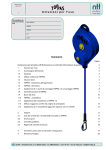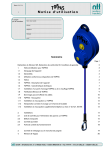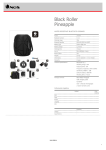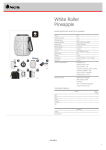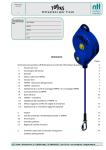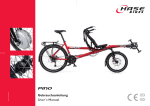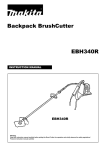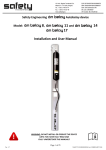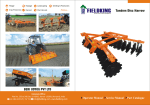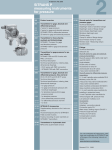Download Operating instructions - NTT Neuhaus Trans Tech GmbH
Transcript
Version 01/13 Operating instructions 1 To be filled in by the retailer _________________________________ Name, Company _________________________________ Address: _________________________________ Telephone _________________________________ Fax _________________________________ Email: Contents Page EC Manufacturer's declaration/EC Declaration of conformity/Guarantee provisions 2 1. Operating instructions 3 1.1 Device identification 3 1.2 General information 3 1.3 Intended use of TOPPAS 4 1.4 Brief instructions 6 1.5 TOPPAS - description of device 7 1.6 TOPPAS - technical data 7 1.7 Attaching a TOPPAS anchorage point or a TOPPAS deflector 8 1.8 Checking/inspecting the TOPPAS 9 1.9 Damage to the cable 10 1.10 Toppas – carabiner 12 1.11 Attaching the carabiner to the TOPPAS 12 1.12 Proper handling and attachment of cable harness 12 1.13 Attaching the additional carabiner (Optional Art. No. 50129) 13 2. Annexes 14 2.1 Checklist for troubleshooting the TOPPAS 14 2.2 Distinctive faults 16 2.3 Daily checks 17 2.4 Operation inspection sheet 18 3. Inspection and cleaning under the grip sleeve 19 4. Revision of Toppas 20 GmbH • St-Korbinian-Str. 8 • D-83626 Valley • Telephone 08024/50 37 • Fax 4 99 44 • www.ntt-valley.de • [email protected] Operating instructions 2 EC Manufacturer's declaration/EC Declaration of conformity/ ntt Neuhaus Trans Tech GmbH, St.-Korbinian-Str. 8, 83626 Valley declares that TOPPAS descender device with carabiner Serial No.: Operating company: delivered by ntt Neuhaus Trans Tech GmbH complies with the following prevailing safety regulations: TOPPAS Carabiner Operating instructions/ Identification EN 341 / EN 360 EN 362 / EN 12275 Type K EN 365 sign affixed sign affixed The TOPPAS can be used as a climbing system/anchorage device only in combination with other components. It may not be commissioned until it is ensured that the entire system complies with the stipulations of EC directives/standards. The TOPPAS has been tested in accordance with the prevailing EN standards. ntt shall not bear any liability for deliveries in countries which do not accept this standard or which use standards or legal grounds deviating from this standard. ntt has covered the normal operations of the device through an industrial third party insurance. Within the scope of this insurance, ntt is liable to the buyer. Other claims, especially claims for damages arising from subsequent damage, are ruled out irrespective of the legal grounds. If the device is re-sold or rented out, the seller is under obligation to notify it to ntt, to document the condition of the device and to provide the video of current instructions to users and operating companies. Guarantee provisions 1. ntt assumes guarantee for manufacturing and material defects for the duration of 24 months after the date of delivery. This shall not affect the inspection and maintenance intervals to be followed 2. For devices repaired by ntt, we assume guarantee for proper installation and replaced spare parts. Any claim for guaranteed, general function and safety of older devices has been ruled out. 3. This guarantee does not include any other liability and includes replacement and repairing of parts detected as defective by ntt. 4. For checking the complaints and repairs, please send the TOPPAS to the address of ntt. ntt shall not bear any costs for transportation or consequential damage, costs for dismantling, installation, packaging or downtime. 5. The guarantee does not include - parts that wear out prematurely due to intensive usage (e.g. safety cable) - Parts of other manufacturers and the parts that have not been installed by ntt - The TOPPAS and parts that have been modified or repaired without the manufacturer's consent - The TOPPAS and parts that are damaged due to improper usage and application. 6. The TOPPAS and accessories must ensure the safety of persons; they must therefore be installed, operated, handled and repaired as per the manufacturer's specifications. Depending on the load and condition, ntt must repair the TOPPAS and accessories at regular intervals, however, at least after every 12 months, and check them for their flawless condition. The prevailing statutory regulations applicable at the installation site must be observed. 7. Guarantee claims can be asserted, only if these legally-binding guarantee provisions are signed by the customer or the operation company and sent back to ntt. With their signatures, the customer and/or the operating company agrees to these guarantee provisions. 8. In case of a guarantee claim, always send a copy of the signed guarantee provisions. , da To be filled in by the operating company: Invoice address: Delivery address: ________________________ ________________________ ________________________ ________________________ Address Address ________________________ ________________________ Telephone Telephone ________________________ ________________________ Fax Fax ________________________ ________________________ Email Email Name, Company Name, Company _____________________________, date _____________ ________________________________________________ - Operating company / Customer / Retailer - ___ - GmbH • St-Korbinian-Str. 8 • D-83626 Valley • Telephone 08024/50 37 • Fax 4 99 44 • www.ntt-valley.de • [email protected] Operating instructions 3 1. Operating instructions 1.1 Device identification The TOPPAS is identified at the front and rear side of the device as well as on the grip sleeve 1. Manufacturer: ntt GmbH St-Korbinian-Str. 8 D-83626 Valley 2. Certifying authority: DEKRA EXAM GmbH Dinnendahlstr. 9 D-44809 Bochum CE 0158 3. Brief instructions 4. Device number 5. Year of manufacture 6. Cable length (20 or 30 m) 7. Yearly mandatory test 8. Pictogram 9. Grip sleeve references 1.2 General information These user instructions are applicable for TOPPAS descender device, tested as per EN 341 and EN 360, available with a 20 m or a 30 m cable with an integrated protection tube (60 cm), grip sleeve, including the EN 12275 compliant carabiner by PETZL Am'D BALL LOCK (automatic dual lock) as well as an upgrade option with two additional one-hand carabiners. The aforementioned components form a unit and may not be changed or extended. Operating instructions as well as the video are regularly updated and can be downloaded from http://www.ntt-valley.de/e-toppas.html. The customer/reseller of TOPPAS must ensure that the latest version of these instructions to users and operating companies and the video are provided to the end customer, the in-charge and users of TOPPAS, and that they have understood and will follow these instructions. If required, these instructions and the video can be provided in the language of a particular country. The name of the end customer must always be notified to us. The end customers or user must be able to handle TOPPAS properly. Please contact ntt for information and training courses. Protect the TOPPAS against unauthorised access GmbH • St-Korbinian-Str. 8 • D-83626 Valley • Telephone 08024/50 37 • Fax 4 99 44 • www.ntt-valley.de • [email protected] Operating instructions 4 1.3 Intended use of TOPPAS The TOPPAS must be used for the intended purpose only in the technically flawless condition. In case of faults or damage, the operation of TOPPAS must be stopped immediately and NTT must check it. The operation inspection sheet must be updated daily The operating company and/or the company must ensure that the user instructions have been understood and are followed, are always accessible and at least a brief instructions sheet (pictogram) is affixed near the installation site. The supplier/manufacturer shall not be responsible for damage caused due to improper usage or modification of the TOPPAS. The TOPPAS functions as an effective system only in combination with an anchorage device and a personal full body or climbing harness. The TOPPAS does not hold the user, but allows him/her to descend in a decelerated manner. It therefore does not provide protection against free falls, snagging, banging or bumping. WARNING! If the descent process is interrupted or if the user snags onto something, he/she should not change his/her position even if it is uncomfortable. The safety cable must remain tautly connected with the user. The carabiner should never be disengaged and the safety cable should not be pulled out. A rescue operation must be initiated in such a case. Only then can the protection against falls be ensured in such a situation. If the retraction process is interrupted when climbing, i.e. if the cable attached to a person or a device slackens, the climbing process must be stopped immediately. The aforementioned information must be given to every user before starting the climbing process. A safety and functional test must be conducted before using the TOPPAS each time. Check whether the carabiner is clean and locks automatically with minimal effort The braking effect must be noticeable when pulling the TOPPAS cable, When retracting, the TOPPAS cable must be retracted completely using a tractive force of min 1 kg (without an auxiliary cable) The cable should not slacken when climbing. The entire section of the TOPPAS cable must be undamaged. The completely spooled-in state indicates an out-of-use position. The TOPPAS cable should therefore not be released freely, but in a controlled manner using an auxiliary cable and under pre-tension. The auxiliary cable must be extremely light and should not be attached to the cable, the blue tube or the grip sleeve, but to the carabiner Twists in the cable may damage it Depending on the load and condition, ntt must repair the TOPPAS at regular intervals, however at least once a year. A carabiner may need to be inspected or replaced prematurely in case of intensive usage (Checking the wear - see page 9) or due to other conditions (e.g. damage to the cable, see page 10). Negligence could be fatal or lead to severe damage. Only the certified anchorage points and anchorage device compliant with EN 795/12572 must be used. These must be positioned perpendicular over the descent or landing area. The load bearing capacity of the TOPPAS is 8 kN and 16 kN at a 180° deflection pulley. TOPPAS may be installed only at such a height that a pull-out reserve of at least 2 m is always available In case of a suspended arrangement, the TOPPAS must be attached at an adequate distance from the climbing wall (minimum 200 mm) such that it is flexible in all directions. It must be ensured that the load is transferred over the large area of the TOPPAS suspension and the deflections at the cable inlet and outlet are minimal in all operating conditions. (Also see the instructions for installing the accessories) Climbing grips must be procured and positioned such that no lateral, banging or oscillating movements are possible in the upper section and the possibility of climbing over the TOPPAS is ruled out. Deviating applications, installation positions, modifications or additions to the device unit must be checked and approved by ntt in writing. The distance between the TOPPAS and the landing area should not be greater than the maximum cable length of the TOPPAS. GmbH • St-Korbinian-Str. 8 • D-83626 Valley • Telephone 08024/50 37 • Fax 4 99 44 • www.ntt-valley.de • [email protected] Operating instructions 5 The descent area must be free from persons, obstacles and possibilities of snagging. The landing area must be covered using shock-absorbing material in conformity with the applicable standards. The TOPPAS cable and the blue protection tube with a grip sleeve should not run over edges or should not be deflected using carabiners or inadequate deflectors which hinder the free cable retraction and should not be bent towards each other or twisted when handling the protection tube with the black grip sleeve. Only a suspended installation position is allowed for outdoor applications. A rain hood must be provided in such a case. Operation must be stopped if there are any indications of thunderstorms or if darkness sets in. Wind the TOPPAS cable (protection against lightning) The TOPPAS should not be exposed to extreme temperatures (< -15 °C, > +60 °C) or chemicals, high humidity over a long time, splash water from below, corrosive sea air, sand, dust, etc. The drawing-in speed may reduce at operating temperatures below 5 °C In case of long standstill periods, dismantling the TOPPAS is recommended. Store it in a dry place at room temperature. The TOPPAS cable must be kept free of dirt and grease (cloth). It should however not be degreased using solvents. The TOPPAS may be used only by one person who has completed the professional training and is well aware about the functioning of the carabiner, proper attachment of the climbing harness, the climbing and descent process, landing as well as detaching the carabiner. TOPPAS may not be serviced or used by persons with restricted physical and mental ability or persons without adequate experience and knowledge. Basic knowledge of the climbing process is a prerequisite. In the initial position, when descending and after landing, distortions that may lead to twists in the cable must be avoided. Always ensure that there are no twists in the cable. Users must be in a good physical condition suitable for this sport. The full body or climbing harness used must be flawless and it must be ensured that the increased catching forced in case of a possible overhead crash are securely absorbed and that any chance of the climbing harness slipping is ruled out. When handled properly, this action is ensured by a complete harness or a sit harness in combination with a breast harness equipped with an EN 361/12275 compliant cable ring or a retainer ring at the front. Harnesses and clothes must fit snugly over the body. Loose objects such as mobile phones, keys, coins and spectacles (unless the spectacles are unbreakable and worn) should not be taken along. Users are not allowed to "climb over" the TOPPAS. The cable must not slacken. The TOPPAS cable must not be subjected to excessive lateral movements and users are not permitted to jump onto the cable. Suitable rescue measures must be provided in case of excess speed, blocking or snagging. Devices such as climbing ropes, climbing clamps, ladders, etc. can be used as rescue aids. A speedy rescue operation must be possible. Unless otherwise specified by the operating company, liability for the following cases is ruled out: Persons under the influence of drugs Persons with body weight under 20 kg Using a non-original harness or carabiner and direct consequences associated with it, see above. Dirty clothes due to leakage of lubricant (device, cable) GmbH • St-Korbinian-Str. 8 • D-83626 Valley • Telephone 08024/50 37 • Fax 4 99 44 • www.ntt-valley.de • [email protected] Operating instructions 6 1.4 Brief instructions Info! 16kN 8kN m a x. + 6 0 °C 1m/s CD-ROM m in . 8kN I. D a ily 1 kg check RESCUE D a ily II. D a ily check - 1 5 °C C heck 2. 1. 3. C B ra k e III. D a ily 1 m /s check C lic k ! < 20 kg GmbH • St-Korbinian-Str. 8 • D-83626 Valley • Telephone 08024/50 37 • Fax 4 99 44 • www.ntt-valley.de • [email protected] Operating instructions 7 1.5 TOPPAS - description of devices The TOPPAS is an automatic safety device for ascending and descending processes, e.g. artificial climbing walls, stunts, shows. It is used for securing one person from top (TOP) (PersonalAscentSafety) without any assistance by another person - hence the name TOPPAS The TOPPAS consists of a closed casing. The TOPPAS cable is rolled onto a spring-loaded cable drum. The descent path is restricted by the total length of the cable as given in the device identification. The TOPPAS has a service brake. When descending, the descent velocity is restricted to approximately 1 m/s. However, the user does not come to a standstill. An additional safety brake with an impact restrictor works only in case of unplanned excess speed. TOPPAS - device accessories Rain hood (outdoor applications) Different brackets 1.6 TOPPAS - technical data Dimensions (H/B/D): 57 x 30 x 15 cm Descent velocity: Approximately 1.00 m/s Weight: 23 kg Drawing-in speed: Approximately 0.50 m/s Drawing force: Min 1 kg (10 N) without an auxiliary cable Cable/extension length: 20 m/30 m Brakes: Centrifugal brake system with three shoes max. pemissible useful length: 18/28 m Blocking system: Independent, speed-controlled, Cable type: Steel cable Inspection interval: Cable diameter: 5 mm Permissible load: 1 person dynamic blocking system At least once a year; even shorter depending on the load and condition GmbH • St-Korbinian-Str. 8 • D-83626 Valley • Telephone 08024/50 37 • Fax 4 99 44 • www.ntt-valley.de • [email protected] Operating instructions 8 Attaching a TOPPAS anchorage point or a TOPPAS deflector (Especially for climbing walls) Also refer to corresponding instructions for anchorage devices. The anchorage point for the TOPPAS must be calculated such that a load of 8 kN or 16 kN can be induced for 180° deflection pulleys by taking the component safety into account. The cable must wind up linearly when descending (along the main axis of the device). The load must be transferred to the bracket over a large area (large pins or sleeves). Climbing grips must be positioned such that the cable deflection is minimal (see the figure) in order to prevent oscillations. In case of a perpendicular or incline installation (cable guide over pulleys), the TOPPAS must be aligned securely. We also refer to DIN EN 12572-1 for safety issues related to manufacturing, dimensioning and inspection of climbing walls 200 m m T O P P A S u n iv e r s a l a t t a c h m e n t a s c e il i n g a t t a c h m e n t a s w a ll a tta c h m e n t TO PPAS B ra k e 1170 m m c a b le g u i d e b lu e p r o t e c t in g t u b e b la c k g r i p s le e v e R u b b e r r in g / S a f e t y R i n g C a r a b in e r H ig h e s t g r i p 15° S m a lle s t a n d m o s t 30° 15° m a in a x is 30° le n g th 1 8 /2 8 m d if f i c u l t t o p g r ip s p e m is s ib le u s e fu l 1.7 D e l i m it a t io n s e c t o r u p t o t h e r e c o m m e n d e d m a x w id t h o f 2 m a u x il i a r y r o p e f o r t h e T O P P A S c a b l e in r e s t p e r io d GmbH • St-Korbinian-Str. 8 • D-83626 Valley • Telephone 08024/50 37 • Fax 4 99 44 • www.ntt-valley.de • [email protected] Operating instructions 9 1.8 Checking/inspecting the TOPPAS The operating company/owner of the TOPPAS must inspect it at least once a year, irrespective of the working conditions or even prematurely or earlier if the cable or the device is damaged. In case of damage, malfunctions or failures, the operation of the TOPPAS must be stopped immediately and it must be sent back to the manufacturer for inspection. The inspection is exclusively carried out by ntt GmbH, St.-Korbinian-Str. 8, 83626 Valley. Before every use, an expert must check the TOPPAS device, the TOPPAS cable, the carabiner, the full body or climbing harness for the condition, functioning, completeness and possible damage. Moreover, an operation inspection sheet must be maintained, see 1.12 for this purpose. Checking the wear and tear in the TOPPAS and the cable inlet Defective installation or intensive use of the TOPPAS (e.g. lateral deflection of the cable) can be detected through corresponding wear marks in the feed hopper of the cable guide. Original condition feed hopper of the cable guide TOPPAS-cable Wear condition that makes premature inspection essential TOPPAS-cable Defective cable inlet due to strong diagonal pull; service life of the cable is reduced Intake traces Distinct cable guiding marks are visible on the hopper surface due to diagonal pull (lateral climbing, impacts) TOPPAS-cable GmbH • St-Korbinian-Str. 8 • D-83626 Valley • Telephone 08024/50 37 • Fax 4 99 44 • www.ntt-valley.de • [email protected] Operating instructions 10 1.9 Damage to the cable The TOPPAS cable must be monitored and checked reliably and with utmost care. Negligence could be fatal or lead to severe damage. Every day or after short intervals in case of intensive usage, check the TOPPAS cable for wire breakage or other changes and whether it can be drawn smoothly over the entire range of usage since the drawing function may be damaged due to wire breakage. (See the operation inspection sheet). Always wear safety gloves when working. Pull out the TOPPAS wire cable over the entire range of use and then slowly unwind it manually up to the blue protection tube by deflecting it slightly. When unwinding, keep the cable under pre-tension and always pull it tight in one go (compact winding). Push the blue protection tube from the black grip sleeve upwards. This will bend the cable. Check this cable section and especially the section up to the black grip sleeve thoroughl. The grip sleeve has a slot through which the cable can be seen up to the pressing. This slot can also be used to clean the cavity (compressed air). Then push the black grip protection tube by approximately 30 mm into the black grip sleeve; see the marking on the tube. If you can no longer push the protection tube or push it with great difficulty, it indicates a possible wire breakage. In exceptional cases such as extreme contamination or exposure to corrosive mediums, even the black grip sleeve can be completely removed along with the blue protection tube for the purpose of inspection and cleaning. See chapter 3 for the procedure. In case of the following damage types, the TOPPAS cable must be replaced immediately irrespective of its condition: More than 1 wire breakage in the entire cable. Wire breakage means a broken individual wire. Patches of rust or bluish marks (outdoor application after a lightning Cable diameter reduced to < 4.9 mm Deformations or damages in the cable as illustrated: Wire breakage Wire breakage at the thimble Crimping Remaining cable deformation Remaining cable deformation on grip Kink Wire breakage on the black grip sleeve Rust Rust at the cable in the grip sleeve GmbH • St-Korbinian-Str. 8 • D-83626 Valley • Telephone 08024/50 37 • Fax 4 99 44 • www.ntt-valley.de • [email protected] Operating instructions 11 Handling when checking the cable Cable is OK Cable is defective Critical places for examination end of o p e ra tin g a r e a b lu e p r o te c tio n tu b e N o te ! p u s h in th e b lu e p r o te c tio n tu b e In s e rtio n d e p th S e e m a r k in g B la c k g rip s le e v e w ith s lit GmbH • St-Korbinian-Str. 8 • D-83626 Valley • Telephone 08024/50 37 • Fax 4 99 44 • www.ntt-valley.de • [email protected] Operating instructions 12 1.10 TOPPAS – carabiner The prescribed Petzl Ball Lock carabiner offers the advantage of easy handling with automatic dual lock without pulling or pushing only if the user is aware of the function.The carabiner is safe only if it locks automatically, which means that it must be checked every day for smooth operation and locking. (see the operation inspection sheet). The carabiner must be changed immediately if the rotating sleeve or the snap catch mechanism does not function or lock automatically and smoothly, and if deformations/wear are visible. 1.11 Attaching the carabiner to the TOPPAS Follow the drawing when inserting the rubber bushing and the carabiner. Petzl AM’D Ball Lock Press - Turn - Open Rubber ring (Spout) . Snap catch Rotating sleeve Safety ring (O-ring) Tip: Apply lubricant on the spout or the safety ring and then on the carabiner so that they can be assembled easily 1.12 Proper handling and attachment of cable harness Do not bend the grip sleeve of the protection tube. GmbH • St-Korbinian-Str. 8 • D-83626 Valley • Telephone 08024/50 37 • Fax 4 99 44 • www.ntt-valley.de • [email protected] Operating instructions 13 1.13 Attaching the additional carabiner (Optional Art. No. 50129) The interconnected dual carabiner safety device is a customary "redundant" and easy-to-handle solution for alpine climbing. It is installed on the built-in Petzl Ball Lock carabiner. The spring securing element is inserted into the carabiner sleeve to ensure protection against opening and theft. Open the carabiner Insert the spring securing element into the open carabiner Close the carabiner Press and turn (clockwise) the spring securing element on the aluminium sleeve of the carabiner Push the spring securing element up to the end in the opening GmbH • St-Korbinian-Str. 8 • D-83626 Valley • Telephone 08024/50 37 • Fax 4 99 44 • www.ntt-valley.de • [email protected] Operating instructions 14 2. 2.1 Annexes Checklist for detecting and rectifying the faults in the TOPPAS Please fill in this list and send it to us in case of faults No. Problem Yes No Cause Solution 10 Carabiner 11 Snap catch is not functioning smoothly Dirt in the joint Blow clear 12 Snap catch does not close automatically Contaminated rotating sleeve Clean, blow clear Snap catch does not engage into the base plate The base plate slot is dirty Clean The base plate slot is deformed Replace the carabiner Anti-twist lock (green ball) The base plate slot is dirty Clean, blow clear does not function The base plate slot is deformed Replace the carabiner 13 14 Rotating sleeve deformed, defective Replace the carabiner spring 15 Additional carabiner 16 Snap catch is not functioning smoothly Dirt in the joint Blow clear 17 Snap catch does not close automatically Lock is deformed Replace the carabiner Spring has slackened Replace the carabiner 18 Snap catch does not engage into the base plate The base plate slot is dirty Clean 20 Device 21 Device jerks when descending 22 Descent process is interrupted (Engage the safety brake) 23 24 Blow clear the brake (Use 2 holes at the bottom) Magnesium or moisture in the brake Let it dry (use the rain hood) Foreign bodies in the toothing Inspection Blow clear the brake Moisture in the Brake (Use 2 holes at the bottom) Let it dry (use the rain hood) Dust, worn out brakes, Defective diversion or deflection in front of the TOPPAS Select the correct pulley Damage to the Housing Inspection in the factory Unknown Inspection in the factory Water in the brake Let it dry (use the rain hood) Foreign bodies in the brake Inspection in the factory Defective diversion or deflection in front of the TOPPAS Select the correct pulley is too slow, irregular, interrupted Damage to the housing Inspection in the factory Spiral deformations in the cable Inspection in the factory Partial cable deformation, wire breakages Inspection in the factory Overlapping Pull out the cable completely and slowly wind it again under pre-tension Spiral volute spring broken Inspection in the factory Unknown Inspection in the factory Auxiliary cable is too heavy Lighter auxiliary cable Impermissible carabiner Use the original carabiner Descent process is too fast Retraction process GmbH • St-Korbinian-Str. 8 • D-83626 Valley • Telephone 08024/50 37 • Fax 4 99 44 • www.ntt-valley.de • [email protected] Operating instructions 15 No. Problem Yes No Cause Solution 30 Cable 31 Spiral deformation or Cable outlet is not centred Inspection in the factory corkscrew shaped deformation The TOPPAS is not aligned linearly Align the TOPPAS properly The TOPPAS cable has jumped from the pulley Defective diversion or deflection in front of the TOPPAS Select the correct pulley, see the instructions for accessories Frequent oscillatory movement with Monitoring a lateral pull 32 Wire breakages (A maximum of 1 wire breakage in the entire cable area Revision) 33 Cable guide has worn out diagonally Defective diversion or deflection in front of the TOPPAS, climbing from the side or top Inspection in the factory Cable kink due to continuous bending stress Inspection in the factory Blue tube is not in the grip sleeve. Observe the marking Frequent severe deformation of the cable in the handling range Monitoring) Constriction in the cable winding Controlled winding of the cable under pre-tension Cable twisted at several places Monitoring Crimped cable Inspection in the factory Service life is expired Inspection in the factory Cable outlet is not centred, distinct cable marks on the cable guide Align the TOPPAS properly and arrange it flexibly Users climbed on the TOPPAS; lateral deviation is too large Remove/replace climbing grips Latest inspection point has reached inspection in the factory Absorption over a large area, Stainless Steel grips 34 Cable guide (see operating instructions – page 9) 40 Miscellaneous 41 Mounting tab is deformed Locating pin is too small Device is damaged from outside Oscillations, impact with the wall Remove/replace climbing grips Incorrect installation, the device hits Suspended installation a surface during use Rain hood damaged The device hits a surface during use Suspended installation 42 Customer's remarks: Customer's name: Customer No.: Device No.: GmbH • St-Korbinian-Str. 8 • D-83626 Valley • Telephone 08024/50 37 • Fax 4 99 44 • www.ntt-valley.de • [email protected] 16 2.2 Operating instructions Distinctive faults GmbH • St-Korbinian-Str. 8 • D-83626 Valley • Telephone 08024/50 37 • Fax 4 99 44 • www.ntt-valley.de • [email protected] 17 2.3 Operating instructions Daily checks 1 2 3 4 5 6 7 GmbH • St-Korbinian-Str. 8 • D-83626 Valley • Telephone 08024/50 37 • Fax 4 99 44 • www.ntt-valley.de • [email protected] Operating instructions 18 2.4 Operation inspection sheet for TOPPAS Operation inspection sheet Operating company: TOPPAS descender device EN 341 class A - 158 Page: Serial 1. 2. 3. 4. 5. 6. 7. No.: Braking action when pulling out Operation smoothness when retracting (1 kg) Check the entire cable, especially at all critical points (see 1.9) and wind under pre-tension Closing function of the carabiner Safety of climbing harness Safety of grips and wall Safety of TOPPAS bracket Check 1-7 Date Signed by Checked by Comment Month: Year: The operating company must ensure that the company or an expert and reliable person appointed by the company will execute the inspection tasks every day before commissioning the device and fill in the inspection sheet. The inspection sheet describes only the important tasks. Detailed information is given in the operating instructions. The obligation to preserve records is applicable for operation inspection sheets. For at least one year after an additional revision is carried out Check 1-7 Date 1. 1. 2. 2. 3. 3. 4. 4. 5. 5. 6. 6. 7. 7. 8. 8. 9. 9. 10. 10. 11. 11. 12. 12. 13. 13. 14. 14. 15. 15. 16. 16. 17. 17. 18. 18. 19. 19. 20. 20. 21. 21. 22. 22. 23. 23. 24. 24. 25. 25. 26. 26. 27. 27. 28. 28. 29. 29. 30. 30. 31. 31. Signed by Checked by Comment GmbH • St-Korbinian-Str. 8 • D-83626 Valley • Telephone 08024/50 37 • Fax 4 99 44 • www.ntt-valley.de • [email protected] Operating instructions 19 3. Inspection and cleaning under the grip sleeve 3.1 Grip sleeve dismantling Protection tube Black Grip sleeve Screws Both screws Loosen three thread runs Safety ring Wire breakages can be clearly seen by bending the wire cable slightly Thimble Loosen the two screws until three thread runs remain. Push the grip sleeve with the protection tube upwards and see the cable section. 3.2 Grip sleeve installing Screw flush Screw flush Safety ring press Align the screw bores with the thimble Press the grip sleeve against the safety ring (system on the carabiner) and tighten the screws without any resistance only until they are flush with the grip sleeve. Push the blue protection tube properly by approximately 30 mm into the grip sleeve. GmbH • St-Korbinian-Str. 8 • D-83626 Valley • Telephone 08024/50 37 • Fax 4 99 44 • www.ntt-valley.de • [email protected] Operating instructions 20 4. Revision of Toppas Remove all loose parts and the parts that do not belong to TOPPAS 4.1 Packing For packing, preferably use the proven returnable TOPPAS transport containers (Art. No. 50020); otherwise packing with at least LxWxH 60x36x23 cm Use only the pure recyclable material as filling material. For non-recyclable material such as foam residues, cushions, etc., we will impose a disposal surcharge Transport weight including the packing is approximately 25 kg 4.2 Accompanying documents Please enclose the following delivery information 4.3 Notifications regarding faults, special features, etc. Your invoice address, bank details, sales tax identification number Delivery address with the desired delivery date Settlement After receiving your TOPPAS devices, we will send you a cost estimate including the freight and packaging for the return consignment After the mandatory payment transfer instructions or payment receipt, your devices will be delivered promptly along with the invoice Cheques and credit card payments shall not be accepted. In case of any difficulty, please contact us at +49 – 8024 – 4 99 00! GmbH • St-Korbinian-Str. 8 • D-83626 Valley • Telephone 08024/50 37 • Fax 4 99 44 • www.ntt-valley.de • [email protected]




















